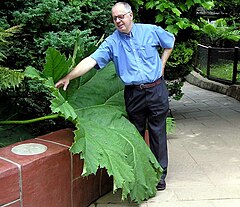| Habit | herbaceous
| |
|---|---|---|
| Height: | ⇕ | 6 ft"ft" can not be assigned to a declared number type with value 6. to 10 ft"ft" can not be assigned to a declared number type with value 10. |
| Width: | ⇔ | 10 ft"ft" can not be assigned to a declared number type with value 10. to 15 ft"ft" can not be assigned to a declared number type with value 15. |
| Lifespan: | ⌛ | perennial, annual |
| Bloom: | ❀ | early summer, mid summer, late summer |
| Exposure: | ☼ | sun |
|---|---|---|
| Features: | ✓ | flowers, ground cover |
| USDA Zones: | 7 to 9 | |
| Flower features: | ❀ | red, pink |
|
Gunnera > |
manicata > |
Gunnera manicata, or giant rhubarb, a native of Brazil, is an ornamental plant in the Gunneraceae family.
The underside of the leaf and the whole stalk have spikes on them. The leaves of Gunnera grow to an impressive size. Leaves with diameters well in excess of four feet are commonplace, with a spread of 10 feet by 10 feet on a mature plant.
This plant grows best in damp conditions eg by the side of garden ponds, but dislikes winter cold and wet. Cover the plant with its own dead foliage to protect the crown in winter.
Read about Gunnera manicata in the Standard Cyclopedia of Horticulture
|
|---|
|
Gunnera manicata, Lind. Stem thick and very short, the titanic crown of lvs. rising from the ground: petioles often as tall as a man, prickly: blades becoming 5-10 ft. across, orbicular in general outline, variously lobed, crenate, furrowed and channelled along the great veins: fls. green: spikes dense and tapering, often more than 1 ft. diam. and 3-4 ft. tall. S.Brazil.—The crown of lvs. sometimes measures 25-35 ft. across, making a magnificent plant. This is the better species.
|
Cultivation
Propagation
Pests and diseases
Varieties
Gallery
References
External links
- w:Gunnera manicata. Some of the material on this page may be from Wikipedia, under the Creative Commons license.
- Gunnera manicata QR Code (Size 50, 100, 200, 500)
